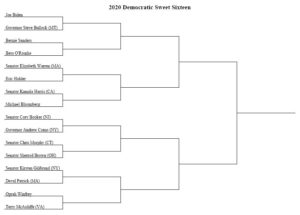Unless Robert Mueller presents unimpeachable (pun intended) evidence Donald Trump is guilty of conspiring to defraud the United States (aka collusion), 2019 will become better known as the first half of the 2020 presidential campaign. I thought I would take this opportunity to share two insights on what we might expect.
Spread the Wealth
It takes money to run for president, a lot of money. And any rational person would think the inability to raise money eventually forces some candidates to reconsider running for the Nation’s highest office. Yet we see anywhere from 25 to 30 Democrats potentially throwing their hats in the ring. And for each of them the outflow of cash begins prior to an announcement. Offices need to be rented. Campaign material must be printed. Websites need to be launched. Can 30 candidates really find the donors to support these initial outlays? Yes, and here is the dirty little secret why.
 In 1984, I served as director of operations for the short-lived presidential campaign of then Senator Fritz Hollings (D-SC). Among my responsibilities was liaison with the campaign treasurer Rene Debacker (Hollings’ personal financial advisor based in Charleston). During a visit to Debacker’s office, he seemed surprised the campaign raised over $1.5 million prior to the New Hampshire primary ($3.6 million in current dollars). The simple explanation. At the time of his announcement, Hollings served as chair of the Senate Commerce Committee and was regularly approached by corporate lawyers and lobbyists seeking to influence legislation before the committee. And each of the lawyers in each of those firms could legally donate $1,000 to each primary candidate.
In 1984, I served as director of operations for the short-lived presidential campaign of then Senator Fritz Hollings (D-SC). Among my responsibilities was liaison with the campaign treasurer Rene Debacker (Hollings’ personal financial advisor based in Charleston). During a visit to Debacker’s office, he seemed surprised the campaign raised over $1.5 million prior to the New Hampshire primary ($3.6 million in current dollars). The simple explanation. At the time of his announcement, Hollings served as chair of the Senate Commerce Committee and was regularly approached by corporate lawyers and lobbyists seeking to influence legislation before the committee. And each of the lawyers in each of those firms could legally donate $1,000 to each primary candidate.
When Hollings announced for president in April 1983, he was favored by less than one percent of registered Democratic voters. Snowballs have a better chance of surviving global warming. And with the prospect Hollings would still chair the Commerce Committee, $1,000 was a small price to pay to stay in the chair’s good graces. And to no one’s surprise, our donors also made equivalent contributions to the other seven candidates for the nomination. For D.C. power players, $8,000 to cover all your bases is chump change.
So, as long as there are no limits on total primary contributions, donating to every campaign is the political equivalent of a hedge fund. Even if there are 30 candidates and a current individual limit of $2,700, we are talking about a total investment of $81,000 to make sure a wealthy, powerful individual can say, “I was there for you from the beginning.” It was only after we had tapped all those $1,000 donors and still finished last in the New Hampshire primary did Hollings drop out of the race [Historical Footnote: The 1984 New Hampshire primary was held on February 28 of a leap year. Hollings announced he was suspending his campaign the next day, a sad anniversary for the campaign which would occur only every fourth year.]
Let the NCAA Run the Democratic Nomination Process
Imagine the equivalent of March Madness as the process for picking a Democratic nominee for 2020. There is a real possibility there will be 32 candidates by end of the year. As noted above, few if any will have an incentive to drop out prior to the Iowa caucuses, leaving a real possibility the winner in this first contest could garner less than 10 percent of the total vote.
I’ve got a better idea. Use the Iowa caucuses to seed the candidates for the New Hampshire primary which would be the round of 32. If there are less than 32 candidates, the best performers in the Iowa caucuses would get a bye in New Hampshire. The NH debates would become a series of one-on-one contests and voters on election day would make up to 16 binary choices.
The round of 16 would be held on Super Tuesday. And so fourth, until the finals which would consist of an electronic ballot by every Democrat who had voted in their respective state primaries. Instead of having a favorite who held on to win (as in 2016), you have the last man or woman standing after a grueling, single elimination tournament. Someone who has peaked in time to take on his/her Republican opponent.
I know it’s not going to happen, but it would put March Madness to shame.
For what it’s worth.
Dr. ESP
